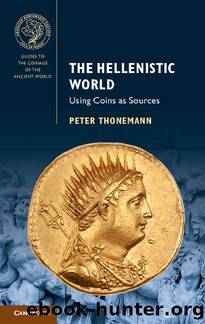Guides to the Coinage of the Ancient World: The Hellenistic World by Thonemann Peter

Author:Thonemann, Peter
Language: eng
Format: epub
Publisher: Cambridge University Press
Published: 2015-11-11T00:00:00+00:00
Figure 5.36. Silver didrachm of the Sicels (c. 214–213 BC). 6.86 g. ANS 1997.9.217.
Figure 5.37. Tetradrachm in the name of Queen Philistis of Syracuse (c. 240–215 BC). 13.60 g. ANS 1964.79.53.
Part III
Political economy
6
Currency systems
I Why mint coins?
Why did Hellenistic kings and cities mint coins? An easy question to pose, but not so easy to answer. In the modern world, most states operate with ‘fiat money’ (Latin fiat, ‘let it be so’), where governments and central banks can increase the amount of money in an economy simply by printing more money (or more complex variants such as quantitative easing). Governments can pursue reasonably sophisticated monetary policies by manipulating the money supply, thereby controlling interest rates and inflation. Few of these measures were available to ancient states. Money in the ancient world mostly took the form of ‘commodity money’, coins which were worth their weight in scarce commodities such as gold or silver. Increasing the money supply meant either digging more gold or silver out of the ground or, more straightforwardly, invading another state and annexing its precious metal reserves, as was done by Alexander the Great between 334 and 330 BC (see Chapter 1 above) and on an even more massive scale by Rome in the second and first centuries BC (Kay 2013; 2014: 21–42).
Without doubt, the main reason why ancient states minted coins was in order to make state payments: paying armies, subsidizing the food supply, funding public works and so forth. In a classic essay, Chris Howgego showed that this can seldom have been the whole story (Howgego 1990). States were aware of the need for a steady supply of coin for day-to-day exchange; they periodically renewed worn coins, and could strike coins for purely ideological reasons (advertising the accession of a new ruler, or proclaiming a city’s independence). The problem for us is to judge how far these various ‘secondary’ motives drove minting behaviour in the Hellenistic world. Our answer will have wide-ranging consequences for our understanding of the Hellenistic economy. Did kings and cities have anything resembling a ‘monetary policy’? Were they aware of phenomena such as inflation and liquidity, and did they try to control them through the coin supply?
By way of example, let us take a look at one recent approach to Hellenistic royal coin production. In his studies of the Seleucid royal economy, Makis Aperghis has argued that the Seleucid royal silver coinage was (at least in peacetime) a ‘replacement’ coinage (Aperghis 2001: 92–5; 2004: 228–46). The amount of silver coinage in circulation in the Seleucid world would naturally have shrunk by c. 1–2 per cent per annum, as a result of coins leaving the kingdom, hoards being buried and not recovered, and so forth. Aperghis argues that the Seleucids minted silver at a rate intended to keep the total money supply roughly stable: ‘the supply of tetradrachms in the market was to be “topped-up” by Seleukid issues whenever it fell below the level required by the economy’ (Aperghis 2004: 230). The number of
Download
This site does not store any files on its server. We only index and link to content provided by other sites. Please contact the content providers to delete copyright contents if any and email us, we'll remove relevant links or contents immediately.
| Coin Folders | Medals |
| Paper Money | State Quarters |
| World Coins |
How to Be a Bawse: A Guide to Conquering Life by Lilly Singh(7137)
Spare by Prince Harry The Duke of Sussex(4751)
Millionaire: The Philanderer, Gambler, and Duelist Who Invented Modern Finance by Janet Gleeson(4052)
Harry Potter 02 & The Chamber Of Secrets (Illustrated) by J.K. Rowling(3532)
Never by Ken Follett(3490)
Machine Learning at Scale with H2O by Gregory Keys | David Whiting(3444)
The Heroin Diaries by Nikki Sixx(3294)
Urban Outlaw by Magnus Walker(3222)
Harry Potter and the Prisoner of Azkaban (Book 3) by J. K. Rowling(3084)
Japanese Design by Patricia J. Graham(2977)
Fairy Tale by Stephen King(2858)
The Man Who Died Twice by Richard Osman(2778)
The Club by A.L. Brooks(2727)
Stacked Decks by The Rotenberg Collection(2664)
Will by Will Smith(2548)
Harry Potter and the Deathly Hallows (7) by J.K. Rowling(2522)
Churchill by Paul Johnson(2331)
The Chimp Paradox by Peters Dr Steve(2199)
Borders by unknow(2093)
